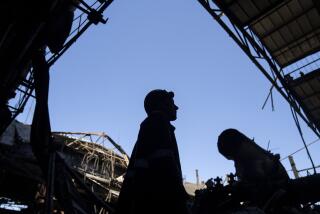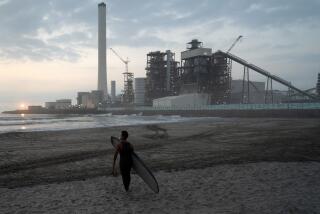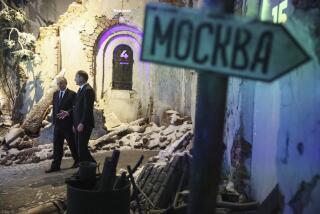Soviet Expert Tells Senators of Effort to Cool Chernobyl
WASHINGTON â A top Soviet scientist, telling a Senate committee Tuesday that the Chernobyl nuclear power plant accident was âunthinkableâ before it happened, gave a dramatic description of how helicopters made hundreds of flights a day to dump sand on the plantâs blazing reactor.
A 150-foot-deep barrier has been built in the soil around the plant to prevent contaminated radioactive water from seeping into a nearby river, Yevgeny P. Velikhov, vice president of the Soviet Academy of Sciences, told the Committee on Labor and Human Resources.
An explosion and fire in Chernobylâs No. 4 reactor last April 26 sent a burst of high-level radiation into the atmosphere. One person was killed by falling debris in the accident, and 30 others have died from radiation sickness.
An additional 237 were hospitalized with radiation sickness, and most of them have recovered and are working, Velikhov said in a rare appearance by a Soviet government official before a U.S. congressional committee.
Soviet planners had designed âmany systems of safetyâ at Chernobyl but âdid not foresee the possibility of multiple errorsâ by workers, Velikhov said. The circumstances were âimpossible,â he said, discussing the complex errors in handling the power output and the flow of cooling water that should have protected the reactor.
In addition, he said, stopping the fire was a major struggle. Helicopters made hundreds of flights daily to drop sand and other material from an altitude of about 600 feet.
Dr. Robert P. Gale, director of the bone marrow transplant division at UCLA, who had joined Soviet doctors in operating on some of the Chernobyl victims, told the committee the radiation will claim additional casualties by increasing the incidence of leukemia and cancers of the thyroid, breast, lung, stomach, liver and colon
Gale said leukemia develops in a few years, while the other cancers will appear after 20 or 30 years.
The 135,000 people living in the vicinity of the plant normally would be expected to have 20,000 cancers, 10,000 of them fatal, during the next 50 years, he said. Radiation from the accident will cause an additional 1,000 cancer cases and 500 more deaths.
Worldwide, the fallout from Chernobyl can be expected to cause 5,000 to 75,000 additional cancer deaths, Gale said.
The exposure for people living within a 10-mile radius was 5,000 times greater at the Chernobyl accident than that of Three Mile Island in 1979, in which radiation was contained in a reactor building.
Nuclear energy has âinseparable benefits and hazards,â Gale said, adding, âNo energy is without a price.â If the Soviet Union shuts down its nuclear power program and turns exclusively to coal and other fossil fuels, the number of deaths would increase by 1 million because of hazards and pollution created by other energy sources, he said.
Committee Chairman Edward M. Kennedy (D-Mass.) called the potential dangers of nuclear power âso awesome,â and declared, âWe live with the knowledge that a nuclear accident, no less than a nuclear attack, can jeopardize the lives of millions.â
More to Read
Sign up for Essential California
The most important California stories and recommendations in your inbox every morning.
You may occasionally receive promotional content from the Los Angeles Times.










